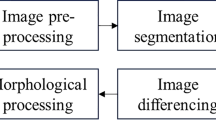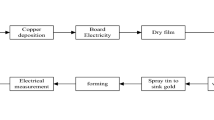Abstract
The traditional global template matching is time consuming, has low accuracy, and cannot be adapted to rotation and scale change. The template matching technique proposed in this study improves the time, accuracy and robustness for printed circuit boards (PCB). In order to shorten the image positioning time, the image preprocessing is implemented on PCB image and the image blocks are labeled to obtain the tagged image, and the feature vector is extracted and the marking point region image is selected. The feature vector with rotation change and scale change robustness is extracted from the tagged image after labeling in the PCB image by using artificial neural network, combined with image moments for training. The marking point region image in the PCB image is selected. The scale value of the marking point region image is estimated by parametric template vector matching. The deflection angle of marking point region image is calculated by Hough transform. The obtained scale value and deflection angle value are used for fast template matching to determine the marking point positioning. The three-dimensional (3D) parabolic curve fitting is implemented in marking point positioning and adjacent pixel position to reach the sub-pixel level accuracy. The experiment showed that the proposed template matching technique for the PCB image with or without noise or angle rotation, the average position accuracy error of each translated image is lower than 7 \(\upmu \)m, and the error standard deviation is lower than 5 \(\upmu \)m. The rotation angle error average and standard deviation of angular error of Hough transform are lower than 0.2\(^{\circ }\), more accurate than orientation code (OC) method. The scale value estimation, relative error average and error standard deviation are lower than 0.004 and 0.006 for the image with or without noise. The average complete positioning time of PCB image at resolution of \(2500\times 2500\) is only 0.55 s, which is better than the 3.97 s of traditional global template matching. The results prove that the template matching technique of this study not only has sub-pixel level high accuracy and short computing time, but also has the robustness of rotation change and scale change interference. It can implement rapid, efficient and accurate positioning.







Similar content being viewed by others
References
Adelson, E., Abderson, C., Bergen, J. R., Burt, P. J., & Ogden, J. M. (1984). Pyramid methods in image processing. RCA Engineer, 29(6), 33–41.
Burt, P. J. (1981). Fast filter transforms for image processing. Computer Graphics and Image Processing, 16(1), 20–51.
Burt, P. J., & Adelson, E. H. (1983). The Laplacian pyramid as a compact image code. IEEE Transactions on Communications, 31(4), 532–540.
Chen, C. S., & Huang, C. L. (2016). A novel image alignment algorithm based on rotation-discriminating ring-shifted projection for automatic optical inspection. Applied Sciences, 6(5), 140.
Choi, M. S., & Kim, W. Y. (2002). A novel two stage template matching method for rotation and illumination invariance. Pattern Recognition, 35(1), 119–129.
Hassaballah, M., & Awad, A. I. (2016). Detection and description of image features: An introduction. In Image feature detectors and descriptors (pp. 1–8). Switzerland: Springer.
Kim, H. Y. (2010). Rotation-discriminating template matching based on Fourier coefficients of radial projections with robustness to scaling and partial occlusion. Pattern Recognition, 43(3), 859–872.
Kim, H. Y., & Araújo, S. A. (2007). Grayscale template-matching invariant to rotation, scale, translation, brightness and contrast. IEEE Pacific-Rim Symposium on Image and Video Technology, Lecture Notes in Computer Science, 4872(1), 100–113.
Lee, W. C., & Chen, C. H. (2012). A fast template matching method with rotation invariance by combining the circular the circular projection transform process and bounded partial correlation. IEEE Signal Processing Letter, 19(11), 737–740.
Li, Z. H., Liu, C., Cui, J., & Shen W. F. (2011). Improved rotation invariant template matching method using relative orientation codes. In Proceedings of the 30th Chinese Control Conference, Yanta (pp. 3119–3123).
Lin, Y. H., & Chen, C. H. (2008). Template matching using the parametric template vector with translation, rotation and scale invariance. Pattern Recognition, 41(7), 2413–2421.
Lewis, J. P. (1995). Fast normalized cross correlation. Vision Interface, 10, 120–123.
Lowe, D. G. (1999). Object recognition from local scale-invariant features. International Conference on Computer Vision, Canada, 2(1), 1150–1157.
Park, Y. S., & Kim, W. Y. (1996). A fast template matching method using vector summation of sub-image projection. Proceedings KSPC, 96, 565–568.
Qiao, N., & Sun, P. (2014). Study of improved Otsu algorithm and its ration evaluation analysis for PCB photoelectric image segmentation. Optik-International Journal for Light and Electron Optics, 125(17), 4784–4787.
Szymanski, C., & Stemmer, M. R. (2015). Automated PCB inspection in small series production based on SIFT algorithm. In 2015 IEEE 24th International Symposium on Industrial Electronics (ISIE) (pp. 594–599).
Tanaka, K., Sano, M., Ohara, S., & Okudaira, M. (2000). A parametric template method and its application to robust matching. IEEE Conference on Computer Vision and Pattern Recognition, Hilton Head Island, 1, 620–627.
Ullah, F., & Kanekoi, S. (2004). Using orientation codes for rotation-invariant template matching. Pattern Recognition, 37(2), 201–209.
Wu, X., Yuan, P., Peng, Q., Ngo, C. W., & He, J. Y. (2016). Detection of bird nests in overhead catenary system images for high-speed rail. Pattern Recognition, 51, 242–254.
Zanganeh, O., Srinivasan, B., & Bhattacharjee, N. (2014). Partial fingerprint matching through region-based similarity. Digital lmage Computing: Techniques and Applications (DlCTA). In 2014 International Conference, IEEE (pp. 1–8).
Zhang, Y., Wang, S., Sun, P., & Phillips, P. (2015). Pathological brain detection based on wavelet entropy and Hu moment invariants. Bio-medical Materials and Engineering, 26(s1), S1283–S1290.
Zheng, Z., & Wang, H. (1999). Analysis of gray level corner detection. Pattern Recognition Letters, 20(2), 149–162.
Acknowledgements
The research was supported by the Ministry of Science and Technology of the Republic of China under Grant No. 104-2221-E-011-156.
Author information
Authors and Affiliations
Corresponding author
Rights and permissions
About this article
Cite this article
Kuo, CF.J., Tsai, CH., Wang, WR. et al. Automatic marking point positioning of printed circuit boards based on template matching technique. J Intell Manuf 30, 671–685 (2019). https://doi.org/10.1007/s10845-016-1274-2
Received:
Accepted:
Published:
Issue Date:
DOI: https://doi.org/10.1007/s10845-016-1274-2




